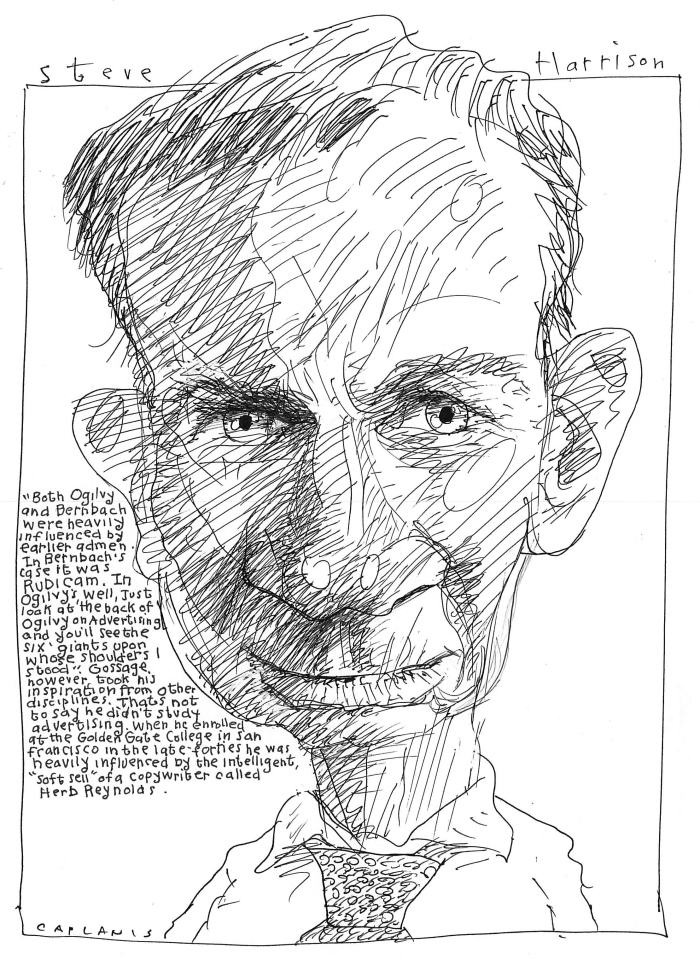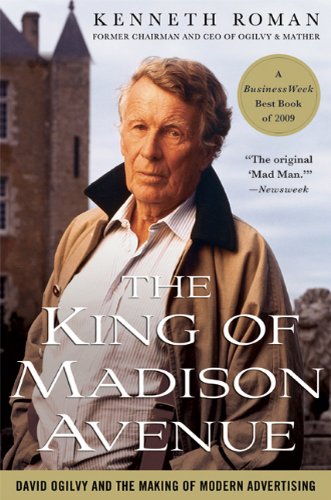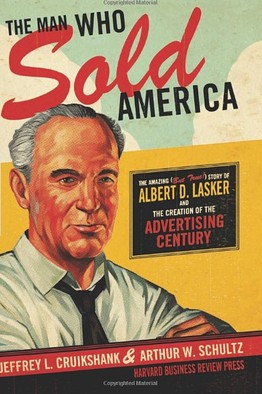
When you get to the end of Steve Harrison’s illuminating and fascinating biography of Howard Gossage you have to ask yourself “Why isn’t Gossage one of the faces on the Rushmore of Advertising?” Bernbach, Burnett, Ogilvy and however many others you want to personally carve into the rockface – but usually no Gossage. Why? Does the pantheon not extend west of the Mississippi? Or is something else at play?
Born in 1917 to a vaudevillian family, Gossage grew up either moving around the Midwest amongst the most creative and eccentric people of the day, or being bored out of his skull on his grandparents’ farm. Such an upbringing might have made the rest of us hopelessly bipolar, but it only fueled Gossage who, after a stint in WW2 as a pilot in the South Pacific (where he was awarded two Distinguished Flying Crosses), he ended up as a copywriter in the small San Francisco shop Brisacher, Wheeler & Staff where he wrote a series of ads for Qantas airlines that should be required reading by anyone in the industry today.
They’re simple – big headline, lotsa body copy, line drawings of airplanes. And oh yeah, he’s giving away a kangaroo. All you have to do is name Qantas’s new airplane.
Besides being brilliantly effective (suddenly America found itself talking about an Australian airline), these ads identify the two distinguishing characteristics of Gossage’s work. One is the crazy, off-the-wall, attention-getting, bright-shiney object. Giving away a kangaroo in 2012 would be noteworthy; in 1953 it was insane.
But the other is his genius for involving the reader. Gossage is often lumped in with direct mail marketers because he often used coupons. But in truth, he didn’t do it to drive trial or sales. He used it to create relationships. Enter a contest, sure. Get some free pink air, okay. But he also would put coupons in ads just so people could drop a line about how they were doing. “People read what interests them” he once said, “and sometimes that’s an ad.” What a revolutionary thought.
And that’s unique to Gossage. Nowhere in advertising will you find so consistent a concern with what the reader will find interesting, and how to become a part of that.
Which is probably why Gossage’s work feels like it inhabits two worlds. On the one hand, its immediately recognizable as being mid-century – long form copy, small graphics that are simple and generally in black & white (or in the case of his legendary Fina Gas ads, black & white & pink. Yes, pink. Harrison’s book is valuable if for no other reason than making these ads available to a new generation). And overwhelmingly print.
But they’re also so completely not of his era. There’s a voice that is friendly, conversational, and “un-sales-y” in a way that is hinted at in Koenig’s first VW ads but never taken to this extreme. They’re wry and clever, but infinitely accessible. They’re ads you actually look forward to.
And Gossage’s iconoclasm didn’t end with the creative. Everything he did was different. He thought commissions on media were an immoral way for an agency to make a living, so he eliminated them. He made Marshall McLuhan a household name. Steinbeck and the Grateful Dead hung out in his office. He wrote radio with Stan Freberg (look him up). He brought the idea of cybernetics to the world and was a confidante of Tom Wolfe. Oh, and he also saved the Grand Canyon.
So with all of this on his resume, why is he still in the shadows? Harrison identifies two reasons. First, unlike Ogilvy, Bernbach and the rest, Gossage really had no interest in creating an agency; he merely used the agency form to do the work that interested him. Indeed, Harrison describes several instances where Gossage either resigned business he was bored with, or didn’t accept business that would have forced him to grow his shop.
And the second reason? He died too soon and in the wrong place. Had he lived in New York, had he lived into the 1970s, the legacy machine would have undoubtedly made him famous (and to be sure, he’s much better known on the left coast where his acolytes and attendants went on to found their own agencies and mythologies)
Globalization, the internet and fine biographies like Steve Harrison’s may change that. But I wouldn’t count on it. Lord knows Gossage wouldn’t have; he’d already be on to the next thing…
Changing the World is the Only Fit Work for a Grown Man by Steve Harrison was published by Adworld Press on 02/28/12 – order it from Amazon here or from Barnes & Noble here – or pick it up at your local bookseller (find one here).
Please be advised that The Agency Review is an Amazon Associate and as such earns a commission from qualifying purchases
You May Also Want to Read:

Steve Harrison, author of Changing the World
is the Only Fit Work for a Grown Man

Madison Avenue
by Kenneth Roman

by Jeffrey L. Cruikshank & Arthur W. Schultz
One of the first reviews I have actually ever finished and I am ordering the book. A man who uses the “agency form” to do the work that interests him. Now…that is a man to learn more about.
Fine written piece Martin.
Excellent review of an outstanding ad man. I spent many years making ads in San Francisco after his time, and his shadow still looms large over every ad creative there. I find myself quoting him all the time and and also wonder why fame eluded him. When it comes to “Madmen”, HLG was the real deal. I’ll definitely order the book.
Martin, the review definitely sucked me in and made me want to read more. Every Mad Man (or Woman) should hope for a review by you!
Dear Carri, my heart sank when I read the first five words of your comment. I am, however, relieved (and delighted) that you liked Martin’s review. I hope you feel the same way about the book. Please let me know if and when you get chance to read it. Cheers, Steve Harrison
Hi Steve – If you’re reading this.
Looks like you’ve been busy since your last book. A quick question. During your research, did you find much more information over and above what Jeff Goodby covered in ‘The Book of Gossage’?
Also, from the coverage the book appears to be generating, part of me is glad to see the word being spread. But there’s a part of me that would like, of all the creative heroes we have in the ad business, for this particular one to stay out of the public gaze, away from the masses.
After all, that was Howard’s style. Just look at how he generated his revenue, with his unwavering philosophy on media spend… ‘A principle isn’t a principle until it costs you money’ – Bernbach.
Less was always so very much more with Howard. And it feels fitting that it should stay that way. Mass was never Howard’s style. Plus, how can we have our heroes if everyone else knows about them. 😉
Not that I don’t wish this latest edition to your books on advertising, all the success I know it deserves. I still recommend ‘How to do better creative work’ to all I believe would benefit from it. Usually MD’s of agencies that don’t see it’s intrinsic value.
James Pearson.
the irony is that a grown man is in actuality an baby. a kid.
let me rephrase this, a grown man has learned to play with the information he has acquired during his/her lifetime.
and polar opposites experiences make for a great perspective in life.
i have a feeling this is the main ingredient to a holistic understanding and perseption of life and work.
the key to having fun in life and work is to play with what you know.
the imperative word here is “play.
i kid you not, i have the feeling Gossage was not interested in the limelight but in the kidding around with our perception thru his illumination, and illuminating works.
thus, i have a funny feeling he saw the agency as a medium while at the same time seeing himself as a medium.
remember, “the message is the medium”, a very very very wise man/kid once said.
so true, so timeless this nugget is.